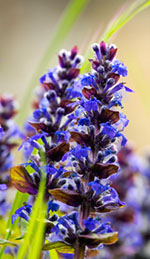 The warming, slightly camphoraceous scent of hyssop oil has been associated with rites of purification, cleansing and sanctification since Biblical times. In aromatherapy, hyssop essential oil has antiseptic, expectorant, and cough suppressant properties [1], and is often included in diffusion blends to chase away winter colds, sinus congestion, and feelings of melancholy. Hyssop essential oil is a colorless to pale yellow-green liquid that blend well with other herbaceous and floral oils such as angelica, clary sage, geranium, melissa, and rosemary.
The warming, slightly camphoraceous scent of hyssop oil has been associated with rites of purification, cleansing and sanctification since Biblical times. In aromatherapy, hyssop essential oil has antiseptic, expectorant, and cough suppressant properties [1], and is often included in diffusion blends to chase away winter colds, sinus congestion, and feelings of melancholy. Hyssop essential oil is a colorless to pale yellow-green liquid that blend well with other herbaceous and floral oils such as angelica, clary sage, geranium, melissa, and rosemary.
Hyssopus officinalis is a shrub native to the Middle East, Southern Europe, and Eastern Europe in the region around the Caspian Sea. It has lance-shaped leaves and produces bundles of blue, pink or white flowers during the summer. Hyssop was known to the Greeks in Classical Antiquity, and some scholars have suggested the word hyssop derives from the related Hebrew word esov or esob, which refers to a plant used in the Old Testament to purify temples and other sacred places. Hyssop also appears in the Bible as a treatment for leprosy. However, some scholars have argued that the hyssop of the Bible is actually a kind of thyme or marjoram, two other aromatic plants with similar antiseptic and cleansing properties.
Whatever the ancient truth, hyssop remained popular as a strewing herb in medieval European churches because it drove away fleas, which carried plague, as well as lice and other pests. Inspired by this use, some Roman Catholic sects still interpret Hyssopus officinalis as the hyssop of the Bible and use the flowers and leaves to scent the water used in purifying rituals called aspersions[1].
Fresh hyssop herb is also used in cooking, although sparingly because it has a strong minty taste with a slightly bitter edge due to the presence of tannins. Along with coriander seed, hyssop leaves are also a part of the complex and closely guarded recipe for Chartreuse liqueur, which makes use of over one hundred different aromatic plants! Bee keepers also sometimes raise bees on hyssop nectar to produce a richly aromatic honey [1].
As a medicine, hyssop essential oil may be diffused to ease respiratory complaints such as congestion, cough, and asthma [2]; it is currently listed in the British Pharmacopoeia for addressing colds and bronchitis [2]. In a massage, hyssop oil acts as a circulatory stimulant, making it helpful for reducing menstrual discomfort, healing bruises and sores, and managing the pain of rheumatism [3]. The oil may also ease digestive complaints when applied to the abdomen [2].
Hyssop essential oil should be avoided during pregnancy, and should not be given to children or people with epilepsy, kidney or liver disease [4], or high blood pressure [2], as hyssop oil can induce a mild increase in blood pressure. Use hyssop essential oil in dilution on the skin, or simply inhale the oil from a diffuser to quickly access its gentle, clarifying benefits.
REFERENCES
1. “Hyssopus officinalis“. Wikipedia. Accessed May 10th, 2014. http://en.wikipedia.org/wiki/Hyssopus_officinalis.
2. Lawless, Julia. 2013. “Hyssopus officinalis” In: The Encyclopedia of Essential Oils: The Complete Guide to the Use of Aromatic Oils in Aromatherapy, Herbalism, Health, and Well-Being. Conari Press.
3 Grieve, M. “A Modern Herbal: Hyssop (Hyssopus officinalis)” Accessed May 14th, 2014. http://www.botanical.com/botanical/mgmh/h/hyssop48.html.
4. Millet Y, P Tognetti, M Lavaire-Perlovisi et al. 1979. “Experimental study of the toxic convulsant properties of commercial preparations of essences of sage and hyssop.” Rev. Electroencephalogr. Neurophysiol. Clin. 9: 8-12.
